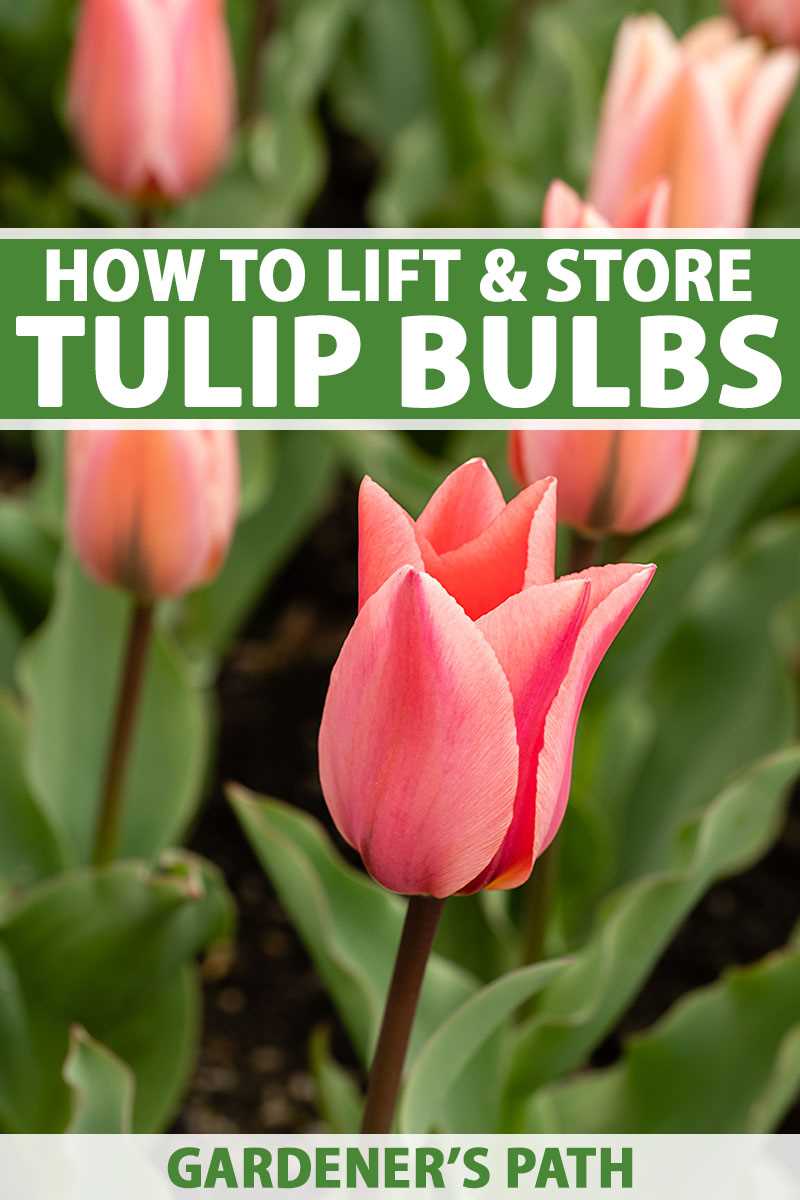- When to dig up tulips after flowering
- 1. Wait until the foliage has turned yellow
- 2. Avoid cutting or removing the foliage prematurely
- 3. Check the bulb for signs of maturity
- 4. Mark the location of the bulbs
- 5. Dig up the bulbs
- 6. Dry and clean the bulbs
- 7. Store the bulbs
- Why it is important to dig up tulips after flowering
- 1. Managing the bulbs’ energy
- 2. Preventing disease and pest problems
- 3. Altering planting arrangements
- 4. Proper storage for bulb longevity
- Preparing for digging up tulips
- How to dig up tulips
- 1. Choose the right time
- 2. Prepare the tools
- 3. Loosen the soil
- 4. Remove the bulbs
- 5. Store or replant the bulbs
- 6. Mulch and water
- 7. Maintenance
- Tools you’ll need to dig up tulips
- Proper technique for digging up tulips
- Storing tulips after digging up
- 1. Remove the soil
- 2. Trim the foliage
- 3. Air drying
- 4. Clean and inspect
- 5. Organize and label
- 6. Storage temperature and conditions
- 7. Regularly check for moisture
- 8. Planning for replanting
- Choosing the right storage location
- Temperature
- Humidity
- Light
- Air Circulation
- Containers
- Location
- Questions and Answers:
- When is the best time to dig up tulips after they have finished flowering?
- How do I dig up tulips after they have finished flowering?
- Can I leave tulips in the ground after they have finished flowering?
- How should I store tulips after digging them up?
- How long can I store tulip bulbs after digging them up?
- Videos: Tulip Aftercare In Pots! What To Do When Flowering Is Over | Balconia Garden
After the beautiful blooming season of tulips comes to an end, it’s important to know what to do with the bulbs. Taking the right steps to dig up and store the tulip bulbs will ensure their longevity and successful blooming in the following year.
Firstly, it is necessary to wait until the tulip plants have finished blooming and the foliage has turned yellow and withered. This typically occurs in late spring or early summer. At this stage, the bulbs have absorbed enough energy to sustain themselves and produce flowers the next year.
To dig up the tulip bulbs, carefully loosen the soil around the plants using a garden fork or a trowel, taking care not to damage the bulbs. Gently lift the bulbs from the ground, removing any excess soil. It is best to do this on a dry day to reduce the risk of fungal diseases.
Once the bulbs are out of the ground, it’s important to clean and dry them before storing. Remove any excess soil or debris, and then place the bulbs in a well-ventilated area to dry for a few days. This will help prevent rot and fungal diseases during storage.
After the bulbs have dried, it’s time to store them for the next season. Use a cardboard box or a mesh bag to keep the bulbs. Place them in a cool, dry, and dark location, such as a basement or a garage. Make sure the storage area has good air circulation to prevent moisture build-up.
Remember to label your tulip bulbs with the variety and the date of digging. This will help you keep track of your collection and ensure proper planting in the future. By following these simple steps, you can enjoy the beauty of blooming tulips year after year.
When to dig up tulips after flowering

Knowing when to dig up tulips after they have finished flowering is crucial for the success of the next year’s bloom. Digging up tulips at the right time allows you to properly store them and ensure they are healthy for the following growing season.
1. Wait until the foliage has turned yellow
After tulips have bloomed, it’s important to let the foliage die back naturally. The leaves will gradually turn yellow and begin to wither. This process usually takes around 6 to 8 weeks, depending on the variety of tulips and the growing conditions.
2. Avoid cutting or removing the foliage prematurely
Although the dying foliage may not look aesthetically pleasing, it is essential not to cut or remove it before it has turned yellow. The leaves are busy replenishing the bulb with energy for next year’s growth. Cutting or removing the foliage too early can weaken the bulb and result in a poor display next year.
3. Check the bulb for signs of maturity
Before digging up the tulip bulbs, carefully check them for signs of maturity. Mature tulip bulbs will have a firm and solid feel. They should have developed a papery outer layer and may have produced small bulblets or offsets.
4. Mark the location of the bulbs
As the foliage turns yellow, it can be easy to forget where exactly the tulip bulbs are planted. To avoid accidentally damaging the bulbs when preparing the soil or planting other flowers, it’s a good idea to mark the location of the bulbs with small stakes or flags.
5. Dig up the bulbs
Once the foliage has turned yellow, it’s time to dig up the tulip bulbs. Use a garden fork or shovel to carefully loosen the soil around the bulbs. Gently lift the bulbs out of the ground, being cautious not to damage them. Shake off any excess soil and trim the foliage down to about 1-2 inches above the bulb.
6. Dry and clean the bulbs
After digging up the bulbs, lay them out in a cool, dry, and well-ventilated area. Allow them to dry for a couple of weeks. Once they are dry, gently remove any remaining soil and remove any dead or damaged scales.
7. Store the bulbs
Store the tulip bulbs in a cool and dry place, such as a paper bag or mesh bag. Make sure the bulbs are not touching each other, as this can promote the spread of diseases. Label the bags with the tulip variety and the date of digging for future reference.
By following these steps, you can ensure that your tulip bulbs are properly stored and ready for planting next season, resulting in a beautiful display of tulips year after year.
Why it is important to dig up tulips after flowering
Tulips, known for their vibrant colors and elegant blooms, are one of the most popular spring flowers. While they bring beauty to our gardens during the flowering season, it is important to dig up tulips after they have finished blooming for several reasons.
1. Managing the bulbs’ energy
After flowering, tulips divert their energy towards producing and storing nutrients in their bulbs. By digging up the tulips, you can ensure that they have the necessary resources to bloom again next year. This process allows the bulbs to replenish their energy reserves and ensures healthy growth.
2. Preventing disease and pest problems
Leaving tulip bulbs in the ground after flowering increases the risk of them being affected by diseases and pests. Digging up the bulbs allows you to inspect them for signs of rot, fungal infections, or damage by pests. Removing any affected bulbs can help prevent the spread of diseases and ensure the overall health of your tulip garden.
3. Altering planting arrangements
Digging up tulips after flowering also gives you the opportunity to rearrange or relocate your bulb plantings. You may want to change the color scheme in your garden, experiment with different combinations of flowers, or simply redistribute the bulbs to create a more balanced and visually appealing display. By taking the time to dig up the tulips, you have the flexibility to make these adjustments.
4. Proper storage for bulb longevity
Storing tulip bulbs properly is crucial for their longevity and future blooming success. Digging up the tulips allows you to properly clean the bulbs by removing any soil or debris. You can then store them in a cool, dry place like a basement or refrigerator to prevent them from drying out, freezing, or being damaged by excessive heat. Following the correct storage procedures will help ensure that your tulips remain healthy and vibrant for the next growing season.
Overall, digging up tulips after flowering is an essential task to maintain the health, beauty, and longevity of these beloved spring flowers. By managing their energy, preventing diseases and pests, altering planting arrangements, and properly storing the bulbs, you can ensure the ongoing success of your tulip garden.
Preparing for digging up tulips
Before digging up your tulips, there are a few important steps you should follow to ensure a successful process:
- Timing: Wait until the tulip flowers have faded and the foliage has turned yellow. This is a sign that the bulbs have finished storing energy for next year’s blooms.
- Choose a dry day: It is best to dig up tulips on a dry day when the soil is not wet or waterlogged. This will make it easier to handle the bulbs and minimize the risk of rotting.
- Gather the necessary tools: You will need a shovel or garden fork, a trowel, a basket or container for storing the bulbs, and some labels or markers to keep track of the different tulip varieties.
Step 1: Mark the tulip locations
- Starting from the outer edges of the tulip bed, mark the locations of each tulip clump. This will help you locate the bulbs later when it’s time to replant or store them.
- Use a stake or marker to indicate the spot where each clump is located. You can also take photos or create a diagram for future reference.
Step 2: Loosen the soil
- Using a garden fork or shovel, gently loosen the soil around the clumps of tulips. Be careful not to damage the bulbs in the process.
- Work your way around each clump, gradually lifting the soil and exposing the bulbs beneath.
Step 3: Lift the bulbs
- Once the soil has been loosened, carefully lift the clumps of tulips from the ground. If there are multiple bulbs in a clump, gently separate them from each other.
- Be mindful of the delicate roots and avoid pulling or twisting them.
Step 4: Clean and inspect the bulbs
- Remove any excess soil from the bulbs by tapping or gently brushing them. Do not wash the bulbs with water as this can increase the risk of rotting.
- Inspect the bulbs for any signs of damage or disease. Discard any bulbs that appear soft, mushy, or discolored.
Step 5: Dry and store the bulbs
- Air dry the bulbs in a well-ventilated area for a few days. This will help to further reduce the risk of rotting.
- Once the bulbs are completely dry, store them in a cool, dark, and dry location. A wooden crate or mesh bag works well for storing tulip bulbs.
- If you plan to store the bulbs for an extended period, consider dusting them with a fungicide powder to prevent fungal growth.
Following these steps will ensure that your tulip bulbs are properly prepared for digging up and storing, resulting in healthy and vibrant blooms next year.
How to dig up tulips
Digging up tulips is a necessary task to ensure the health and longevity of your flowers. Whether you need to relocate them, store them for the winter, or divide them to create more plants, digging up tulips requires careful attention and proper technique.
1. Choose the right time
The best time to dig up tulips is after the foliage has turned yellow and dried up. This usually occurs 6-8 weeks after the flowers have finished blooming, depending on the variety. It’s important to wait until the foliage has fully withered to allow the bulb to store enough energy for the next season.
2. Prepare the tools
Before you start digging, gather the necessary tools, including a spade or garden fork, gloves, and a bucket or container to hold the bulbs. Make sure your tools are clean and sharp to minimize damage to the bulbs.
3. Loosen the soil
Start by loosening the soil around the tulip bulbs with a spade or garden fork. Dig deep enough to avoid injuring the bulbs, but be gentle to prevent accidental damage. Lift the bulbs carefully from the ground, keeping as much soil intact as possible.
4. Remove the bulbs

Once the bulbs are unearthed, gently shake off the excess soil and remove any dried foliage or roots. Discard any bulbs that appear damaged or diseased, as they will not likely survive or may spread diseases to other bulbs.
5. Store or replant the bulbs
If you plan to store the bulbs, place them in a well-ventilated area to dry for a few days. Once dry, remove any remaining foliage and store the bulbs in a cool, dry place, such as a paper bag or a wooden crate filled with peat moss or sawdust. Make sure the bulbs are stored away from direct sunlight and extreme temperatures.
If you want to replant the bulbs immediately, choose a suitable location with well-draining soil and plenty of sunlight. Dig holes that are approximately three times deeper than the size of the bulbs and space them at least four inches apart. Plant the bulbs with the pointed end facing up and cover them with soil.
6. Mulch and water
After planting the bulbs, apply a layer of organic mulch, such as straw or wood chips, to help conserve moisture and regulate soil temperature. Water the newly planted bulbs thoroughly and continue to provide regular watering as needed.
7. Maintenance
Proper care and maintenance are essential for the health of your tulips. Water them regularly but avoid overwatering, as this can lead to root rot. Fertilize the bulbs with a balanced bulb fertilizer according to the package instructions. Remove any weeds and dead foliage to prevent the spread of diseases.
Following these steps will ensure that your tulips are dug up correctly and have the best chance of thriving in their new location or in storage. With proper care, your tulips will continue to bring beauty to your garden year after year.
Tools you’ll need to dig up tulips
Digging up tulip bulbs for storage requires a few essential tools to make the process easier and more efficient. Here are the tools you’ll need:
- Trowel: A hand trowel is a must-have tool for digging up tulip bulbs. It’s small, lightweight, and perfect for carefully loosening the soil and extracting the bulbs without causing damage.
- Garden fork: In some cases, the soil may be compacted or challenging to dig through. A garden fork will help break up the soil and allow for easier access to the tulip bulbs.
- Garden gloves: Protect your hands while digging up tulips by wearing a pair of sturdy garden gloves. This will prevent blisters or injuries caused by thorns or sharp objects in the soil.
- Pruning shears: If the tulip foliage is still green, it’s important to cut off the leaves rather than pulling them out. Pruning shears will make this task quick and clean.
- Marker or labels: To keep track of different tulip varieties, it’s advisable to label the bulbs or use markers to indicate their colors or other characteristics. This will make it easier to plant them again in the future.
- Bulb storage container: Once you dig up your tulip bulbs, you’ll need a suitable container for storing them until the next planting season. A cardboard box or a mesh bag are good options as they provide ventilation to prevent rotting.
Having these tools ready before you start digging up tulips will ensure a smooth and successful process. Remember to handle the tulip bulbs with care to preserve their health and improve their chances of blooming beautifully in the future.
Proper technique for digging up tulips
Digging up tulips requires a careful and precise technique to ensure the bulbs are kept intact and can be stored for future use. Here are the steps to follow when digging up tulips:
- Wait until the tulip foliage turns yellow and begins to wither. This is an indication that the energy from the foliage has been transferred to the bulb.
- Use a garden fork or spade to gently loosen the soil around the tulip bulbs. Be careful not to damage the bulbs in the process.
- Once the soil is loosened, carefully lift the bulbs out of the ground. Use your hands to gently remove any excess soil clinging to the bulbs, being careful not to remove the outer layer.
- Inspect the bulbs for any signs of disease or damage. Discard any bulbs that appear rotten or diseased.
- Allow the bulbs to dry for a few days in a cool, well-ventilated area. This will help prevent mold and rot during storage.
- After the bulbs have dried, gently remove any remaining foliage and trim the roots down to about an inch.
- Store the bulbs in a cool, dry place until planting time. It’s best to store them in a breathable container such as a mesh bag or paper bag.
Following these steps will ensure that your tulip bulbs are safely dug up and stored, ready to be replanted in the future for another beautiful display of flowers.
Storing tulips after digging up
Once you have dug up your tulip bulbs, it is important to store them properly to ensure their health and vitality for the next growing season. Here are some guidelines on how to store tulips after digging them up:
1. Remove the soil
After digging up the tulip bulbs, gently remove any excess soil clinging to them. Be careful not to damage the delicate roots or outer layers of the bulbs.
2. Trim the foliage
Cut off the foliage of the tulips, leaving only about an inch of stem. This helps the bulbs conserve energy and focus on storing nutrients for future growth.
3. Air drying
Place the tulips in a cool, dry, and well-ventilated area to allow them to dry naturally. This will help prevent the bulbs from rotting or developing fungal infections during storage.
4. Clean and inspect
Once the tulips have dried completely, gently brush off any remaining dirt or debris. Inspect each bulb carefully for any signs of damage, disease, or pests. Discard any bulbs that show signs of rot, mold, or insect infestation.
5. Organize and label

Store the tulip bulbs in a cool and dry place. You can use containers, boxes, or mesh bags for storage. Make sure to label each container or bag with the variety and color of tulips to keep track of them easily.
6. Storage temperature and conditions
Tulip bulbs should be stored in a cool and dry place with a temperature between 40-50 degrees Fahrenheit (4-10 degrees Celsius). Avoid storing them near fruits or vegetables, as the ethylene gas released by these can negatively affect the bulbs.
7. Regularly check for moisture
Check the tulip bulbs regularly during storage to ensure they remain dry. If any bulbs become moist or show signs of mold, discard them immediately to prevent the spread of fungal infections.
8. Planning for replanting
When storing tulip bulbs, make sure to plan for their replanting in the next growing season. Take note of the ideal planting time and conditions for your specific variety of tulips to ensure their successful growth and blooming.
By following these storage guidelines, you can help preserve the health and vitality of your tulip bulbs for beautiful blooms year after year.
Choosing the right storage location
When it comes to storing tulip bulbs after they have finished flowering, it is important to choose the right location to ensure their proper growth and preservation until the next planting season. Here are some factors to consider when selecting a storage location for your tulip bulbs:
Temperature
Tulip bulbs should be stored in a cool location with a consistent temperature between 45°F (7°C) and 55°F (13°C). Avoid storing them in areas where the temperature fluctuates drastically, such as near heating vents or in direct sunlight. Extreme temperature variations can cause the bulbs to rot or dry out.
Humidity

The storage location should have low humidity levels to prevent mold and moisture buildup, which can also lead to bulb rot. A dry and well-ventilated area is ideal for tulip bulb storage.
Light
Tulip bulbs should be stored in a dark location to prevent them from sprouting prematurely. Exposure to light can trigger early growth, reducing their viability for planting in the next season. Use opaque containers or cover the bulbs with a cloth or paper to block out any light.
Air Circulation
Air circulation is important to prevent the buildup of moisture and to ensure that the bulbs remain dry. Storing tulip bulbs in ventilated containers or paper bags with holes can help facilitate air movement and prevent condensation.
Containers
Choose containers that provide adequate space for the bulbs to breathe and prevent them from touching each other. Avoid using plastic bags or airtight containers, as they can trap moisture and promote rotting. Instead, opt for mesh bags, paper bags, or wooden crates.
Location
Avoid storing tulip bulbs near fruits or vegetables, as they release ethylene gas, which can cause the bulbs to deteriorate. Additionally, keep the bulbs away from rodents and pests that may be attracted to them.
By considering these factors and choosing the right storage location, you can ensure the long-term viability of your tulip bulbs and enjoy beautiful blooms in the next planting season.
Questions and Answers:
When is the best time to dig up tulips after they have finished flowering?
The best time to dig up tulips after they have finished flowering is when the foliage has turned yellow and has started to wither. This usually happens 6-8 weeks after the flowers have bloomed.
How do I dig up tulips after they have finished flowering?
To dig up tulips, use a garden fork or shovel to gently loosen the soil around the bulbs. Be careful not to damage the bulbs in the process. Once the bulbs are loose, carefully lift them out of the ground. Shake off excess soil and remove any dead foliage.
Can I leave tulips in the ground after they have finished flowering?
While tulips can be left in the ground after they have finished flowering, it is generally recommended to dig them up and store them. This is because tulips are prone to diseases in the soil, and storing them allows you to replant them in a healthier environment the following year.
How should I store tulips after digging them up?
After digging up tulips, remove any excess soil and let them dry in a cool, shaded place for a few days. Once they are dry, you can store them in a cool, dry location such as a basement or refrigerator. It is important to store them in a well-ventilated container or mesh bag to prevent moisture buildup.
How long can I store tulip bulbs after digging them up?
You can store tulip bulbs for several months after digging them up. However, it is important to regularly check the bulbs for signs of mold or rot. If any bulbs are starting to show signs of decay, it is best to discard them to prevent the spread of disease to the other bulbs.







